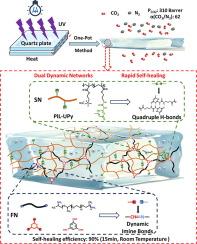Spontaneous and rapid self-healing ionogels membrane based on dual dynamic crosslinking networks strategy for high-efficiency CO2 separation
IF 8.1
1区 工程技术
Q1 ENGINEERING, CHEMICAL
引用次数: 0
Abstract
Ionogels membranes have excellent solubility selectivity for CO2 and show great potential for CO2 separation and capture. However, the poor mechanical properties, susceptibility to damage, and short service life of ionogels membranes have limited their applications. Herein, we employed a novel strategy involving the construction of dynamic dual self-healing networks based on a double network (DN) structure to enhance the self-healing efficiency and mechanical performance of ionogels membranes. The first dynamic chemical cross-linking supramolecular network was formed based on imine bonds. The second dynamic physical cross-linking network was established between the UPy units, which served as a sacrificial network to dissipate stresses and generally enhance the mechanical properties of the DN membranes. When the free ionic liquids (ILs, [EMIM]DCA) were added at 60 wt%, the CO2 permeability (PCO2) was 310 Barrer, and the ideal CO2/N2 selectivity (α (CO2/N2)) was 62, approaching the 2019 Robeson upper bound. Due to the synergistic effect of the dual self-healing networks, the self-healing efficiency of DN membrane was greatly improved. The DN (UPy 5 wt%) membrane exhibited a high stress healing efficiency (σHE) of 95% and a high strain healing efficiency (εHE) of 125% after 1 h of self-healing at room temperature. These values significantly exceeded the self-healing efficiency observed with single self-healing network and approached the upper bound for tensile strength as a function of self-healing time. Additionally, the ionogels membrane exhibited excellent functional recovery and reproducibility. The ionogels membrane underwent three puncture/healing (1 h) experiments, achieving PCO2 self-healing efficiency of 96.8%, 98.1%, and 97.3%, and α(CO2/N2) self-healing efficiency of 89.7%, 87.4%, and 90.3%, respectively. Therefore, the construction of dual self-healing networks is an effective strategy to prepare high performance self-healing gas separation membranes.


求助全文
约1分钟内获得全文
求助全文
来源期刊

Separation and Purification Technology
工程技术-工程:化工
CiteScore
14.00
自引率
12.80%
发文量
2347
审稿时长
43 days
期刊介绍:
Separation and Purification Technology is a premier journal committed to sharing innovative methods for separation and purification in chemical and environmental engineering, encompassing both homogeneous solutions and heterogeneous mixtures. Our scope includes the separation and/or purification of liquids, vapors, and gases, as well as carbon capture and separation techniques. However, it's important to note that methods solely intended for analytical purposes are not within the scope of the journal. Additionally, disciplines such as soil science, polymer science, and metallurgy fall outside the purview of Separation and Purification Technology. Join us in advancing the field of separation and purification methods for sustainable solutions in chemical and environmental engineering.
 求助内容:
求助内容: 应助结果提醒方式:
应助结果提醒方式:


